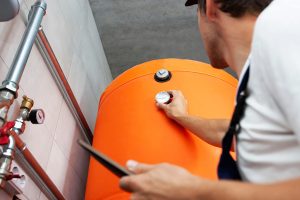Modern heating oil tanks are high quality containers deemed suitable for the storage of domestic oil. These tanks come in various shapes and sizes to suit specific needs. However, it can be difficult to choose the right tank for you from a range of options.
We’ve written this guide to oil tank types to help you understand the pros and cons of each type. Learn more about the different oil storage tank types below.
What are the different oil tank types?
Firstly, oil tanks fall into different categories depending on their construction and intended use:
Single-skinned oil tanks
Single-skinned tanks utilise a single-layer construction. While the benefit of this tank type is its low price point, single-skinned oil tanks have some significant drawbacks. The singular layer makes them more prone to damage, which can lead to various issues and a short lifespan. Crucially, single-skinned tanks have a higher risk of oil leaks than other types of oil tanks.
Single-skinned tanks have fallen out of popularity in favour of other, safer options.
Pros
– Lower price due to cheaper manufacturing costs
Cons
– Prone to leaks and damage
– Shorter lifespan
– Subject to strict regulations
– Expensive clean-up costs if you experience an oil leak
Double-skinned oil tanks
Double-skinned tanks offer an extra, second layer for protection, making them a more secure option than single-skinned tanks. They often consist of a plastic inner tank and steel outer walls. Double-skinned tanks may not always be suitable for premises requiring bunded tanks. That’s because the outer tank does not always contain 110% of the inner tank’s capacity.
Pros
-Higher capacity than single-skinned tanks
– More secure than single-skinned tanks
Cons
– Higher price point
– Outer tanks don’t always meet the conditions for premises requiring bunded tanks
Bunded oil tanks
Integrally bunded tanks are an industry-leading tank option with a crucial benefit. They include a secondary containment system, which acts as an added safety feature. This internal ‘bund’, or tank within a tank, holds the oil, while the outer tank provides an extra layer of protection. The purpose of this type of tank construction is to help prevent oil leaks and spills.
You have the choice of plastic bunded oil tanks, steel bunded oil tanks, and steel/plastic hybrid tanks.
Pros
– Effective leak prevention
– Can hold 110% of the inner tank’s capacity
– Protects against condensation
Cons
– Higher price point
Underground tanks
As the name suggests, underground oil tanks provide the option to store your oil underground. A key benefit of underground tanks is that they are less prone to leaks than their aboveground alternatives. People often consider an underground tank to better protect their oil from theft and to save space. However, installing one can be complicated and it may be necessary to obtain planning permission.
Pros
– Saves space
– Protects against theft
– Low risk of leaks
Cons
– Higher price point
– Difficult to maintain
– May require planning permission
Steel or plastic: choosing oil tank material
You also have a choice between two oil tank materials, which each have unique benefits:
Plastic oil tanks
Plastic tanks are a popular choice as their advantages tend to outweigh the drawbacks. They come in a wide range of shapes and sizes, meaning that most customers can easily find the right tank to suit their needs.
Pros
– Lightweight
– Easy to move
– Range of sizes
– Readily available
Cons
– Repairs not recommended
– Prone to damage from cold temperatures, extreme weather and excess sunlight
Steel oil tanks (also referred to as metal oil tanks)
The main advantage of steel tanks is their durability. Their resilient construction reduces the likelihood of damage from impact. Steel tanks also offer a higher level of protection against theft, as they are difficult to drill into or move around.
However, despite their durable construction, steel tanks are vulnerable to rust and corrosion.
Pros
– Durable
– Possible to repair
– Long lifespan
– Higher protection against theft
Cons
– Rust
– Corrosion
– Higher price point
Where can I buy oil tanks?
We recommend buying your oil tank through a reputable heating oil provider who can help you with the process.
When buying your oil tank through Heatingoil.co.uk, we will guide you through the process from start to finish. We will help you choose the right heating oil tank for you from a selection of high quality affordable Kingspan tanks. Our OFTEC-registered engineers will then take care of the installation for you. Finally, you will benefit from a fresh fill of heating oil once your tank is in position.
Find out more about our stress-free oil tank services and domestic installations.
Contact our expert tank team today to discuss your unique requirements.
Or, read our heating oil tank installation guide to prepare for your oil tank replacement.





